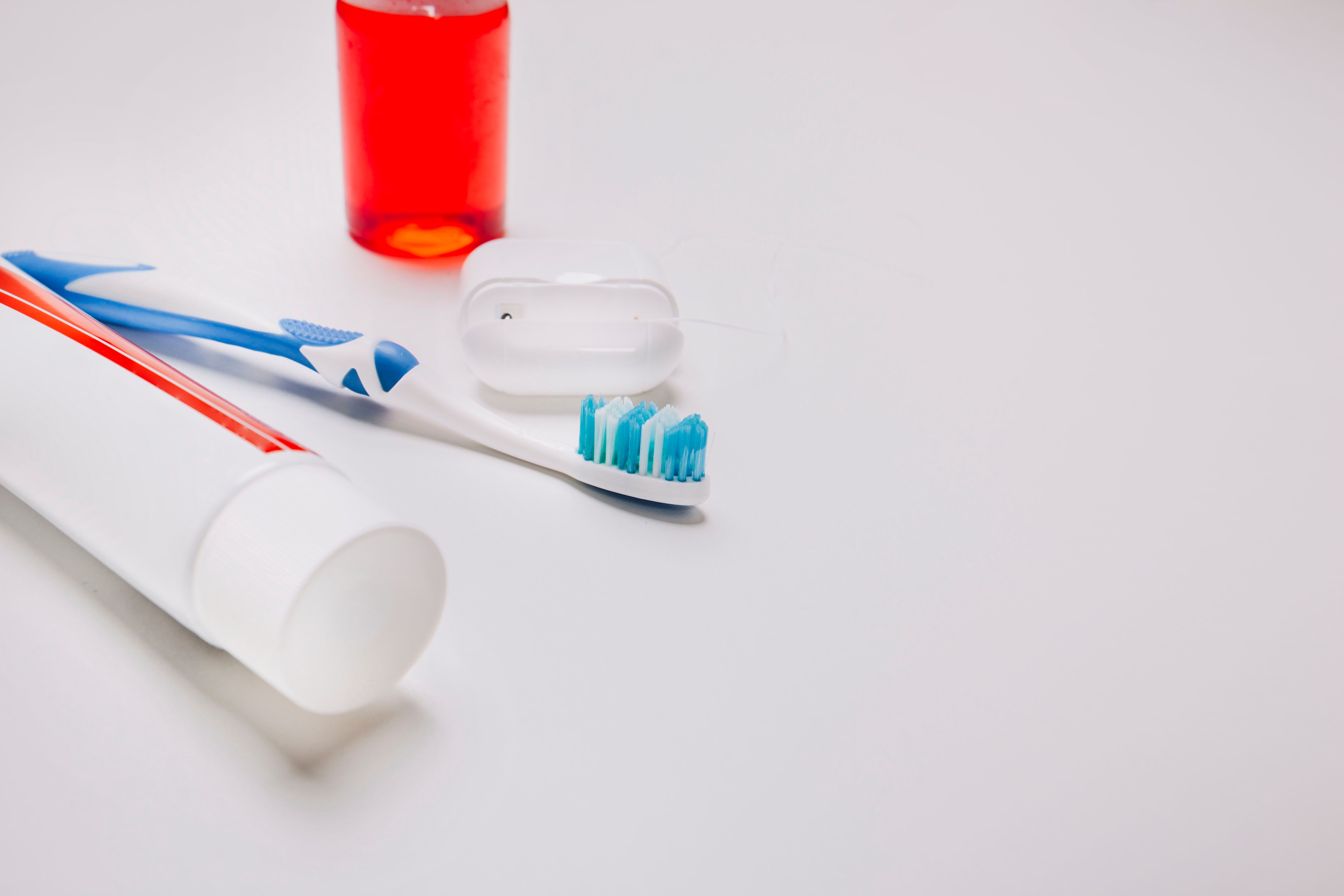October 30, 2025
Can Your Toothpaste Ingredients Cause Sensitivity? Here’s What to Check

Key Points Before Starting
- Tooth sensitivity affects millions and can be triggered or worsened by certain toothpaste ingredients
- Common culprits include abrasive agents, whitening compounds, and specific flavoring additives
- Not all sensitivity is the same - understanding the root cause helps you choose the right products
- Reading ingredient labels matters for managing and preventing tooth sensitivity
- Professional guidance is essential when sensitivity persists or worsens despite product changes
Can Your Toothpaste Ingredients Cause Sensitivity? Here's What to Check
If you've ever winced while sipping hot coffee or eating ice cream, you're familiar with the sharp, uncomfortable sensation of tooth sensitivity. While many factors contribute to sensitive teeth, one often-overlooked culprit might be sitting right on your bathroom counter: your toothpaste. The very product designed to protect your teeth could actually be making sensitivity worse, depending on its ingredients.
Understanding which toothpaste components can trigger or exacerbate sensitivity empowers you to make informed choices for your oral health. Let's explore the ingredients you should watch for and how to select products that support rather than compromise your dental comfort.
What Causes Tooth Sensitivity in the First Place?
Before diving into specific ingredients, it's important to understand the mechanism behind tooth sensitivity. Your teeth have an outer protective layer called enamel, and beneath that lies dentin, which contains microscopic tubules leading to the tooth's nerve center. When enamel wears down or gums recede, these tubules become exposed, allowing hot, cold, sweet, or acidic substances to reach the nerves and cause pain.
Several factors can lead to this exposure, including aggressive brushing, teeth grinding, acidic foods and beverages, gum disease, and yes, certain toothpaste ingredients. Some components in toothpaste can gradually wear away enamel, irritate gums, or directly stimulate the exposed nerve endings in your teeth.
The challenge is that toothpaste formulations are complex, containing anywhere from 10 to 20 different ingredients, each serving a specific purpose. Some are necessary and beneficial, while others might be problematic for those with sensitive teeth. Knowing which is which makes all the difference.
Abrasive Agents: The Hidden Enamel Eroders
Toothpaste needs some level of abrasiveness to effectively remove plaque and surface stains. However, excessive abrasion can gradually wear down enamel, exposing the sensitive dentin underneath and making existing sensitivity worse.
Abrasive ingredients to watch for include:
- Hydrated silica: While generally safe in appropriate concentrations, some formulations contain excessive amounts that can be too harsh for sensitive teeth
- Calcium carbonate: A common whitening agent that can be particularly abrasive, especially in whitening toothpastes
- Sodium bicarbonate (baking soda): Popular for its whitening properties but can be overly abrasive with regular use
- Alumina: Often found in tartar control toothpastes and can be harsh on enamel over time
The abrasiveness of toothpaste is measured by its Relative Dentin Abrasivity (RDA) value. Products with RDA values below 70 are considered low abrasion, 70 to 100 is medium, 100 to 150 is high, and anything above 150 is considered very abrasive. Unfortunately, manufacturers aren't required to list RDA values on packaging, making it difficult for consumers to assess this factor.
If you have sensitive teeth, look for toothpastes specifically formulated for sensitivity, as these typically have lower abrasivity levels. Avoid products marketed primarily for whitening or tartar control, as these tend to be more abrasive.
Whitening Ingredients That Can Increase Sensitivity
The desire for a brighter smile drives many people toward whitening toothpastes, but these products often contain ingredients that can trigger or worsen tooth sensitivity. Whitening agents work by either removing surface stains through abrasion or chemically bleaching teeth, and both methods can have sensitivity side effects.
Hydrogen peroxide and carbamide peroxide are the most common chemical whitening agents in toothpaste. While effective at bleaching teeth, they can penetrate enamel and irritate the tooth's nerve, especially when enamel is already compromised or thin. The concentration in over-the-counter toothpaste is relatively low compared to professional treatments, but with daily use, even low concentrations can cause problems for sensitive teeth.
Blue covarine is a newer whitening ingredient that works differently by creating an optical illusion of whiter teeth rather than actually bleaching them. While less likely to cause sensitivity than peroxide-based ingredients, it's often combined with abrasive agents that can still be problematic.
If you're experiencing sensitivity and currently using a whitening toothpaste, consider switching to a sensitivity-focused formula for at least several weeks to see if your symptoms improve. You can always return to whitening products occasionally rather than using them daily, or explore professional whitening options under dental supervision where sensitivity can be better managed.
Sodium Lauryl Sulfate: The Foaming Irritant
Sodium lauryl sulfate (SLS) is a detergent and surfactant added to toothpaste to create the foaming action many people associate with effective cleaning. While this foam doesn't actually improve cleaning power, it's become an expected feature of toothpaste. Unfortunately, SLS can cause problems for people with sensitive teeth and gums.
Research has shown that SLS can irritate oral tissues, potentially leading to canker sores in susceptible individuals. More relevant to sensitivity concerns, SLS may strip away the protective mucous layer in your mouth, leaving teeth and gums more vulnerable to irritants. Some studies suggest that SLS can also contribute to gum inflammation and recession, which exposes tooth roots and increases sensitivity.
Many toothpaste manufacturers now offer SLS-free formulations, particularly in their sensitivity product lines. These alternatives often use milder surfactants or skip the foam entirely. While the lack of foam might feel strange at first, many people adjust quickly and find their sensitivity improves noticeably after making the switch.
Flavoring Agents and Essential Oils
The fresh, minty taste of toothpaste comes from various flavoring agents, and while these make brushing more pleasant, some can irritate sensitive teeth and gums. Strong flavoring compounds, particularly certain essential oils and synthetic flavorings, may trigger discomfort in people with sensitivity issues.
Potentially problematic flavoring ingredients:
- Menthol and peppermint oil: While popular for their refreshing taste, these can irritate exposed dentin and inflamed gum tissue
- Cinnamon flavoring: Cinnamaldehyde, the compound responsible for cinnamon flavor, is a known irritant that can cause sensitivity and allergic reactions in some people
- Citrus flavoring: Citric acid used in fruit-flavored toothpastes can erode enamel with prolonged exposure
- Artificial sweeteners: While not technically flavorings, some people find that certain sweeteners like saccharin cause mouth irritation
If you suspect flavoring agents are contributing to your sensitivity, look for toothpastes with mild or minimal flavoring. Some sensitivity-focused products specifically advertise "gentle mint" or "mild flavor" options that are less likely to cause irritation.
Ingredients That Actually Help Sensitivity
Not all toothpaste ingredients are problematic for sensitive teeth. In fact, several compounds are specifically formulated to reduce sensitivity and should be sought out if you're dealing with this issue.
Potassium nitrate is one of the most effective and commonly used desensitizing agents. It works by calming the nerves inside your teeth, reducing their ability to transmit pain signals. With regular use over several weeks, potassium nitrate can significantly decrease sensitivity to hot, cold, and sweet stimuli.
Stannous fluoride (tin fluoride) serves double duty by both strengthening enamel and blocking the tubules in dentin that lead to nerves. It's more effective at reducing sensitivity than sodium fluoride, though it can sometimes cause temporary tooth staining in some users.
Arginine and calcium carbonate together form a technology that physically plugs the exposed tubules in dentin, creating a barrier against sensitivity triggers. This approach provides both immediate and long-term relief with continued use.
Nano-hydroxyapatite is a newer ingredient that works by remineralizing enamel and filling in microscopic defects. While more common in international markets, it's gaining popularity in the United States as an effective alternative for sensitivity management.
How to Choose the Right Toothpaste for Your Sensitive Teeth
Selecting the best toothpaste for sensitivity requires a personalized approach based on your specific situation. Start by identifying your primary concerns beyond sensitivity, such as cavity prevention, gum health, or mild stain removal. Look for products that address sensitivity while also meeting these other needs.
Read ingredient labels carefully, watching for the problematic ingredients discussed earlier. If you're currently using a whitening or tartar control formula and experiencing sensitivity, switching to a product specifically designed for sensitive teeth should be your first step.
Give new products time to work. Desensitizing ingredients typically need two to four weeks of consistent use before you'll notice significant improvement. If you don't see results after a month, the product might not be right for you, or your sensitivity may have an underlying cause that requires professional attention.
Consider rotating products strategically. Once your sensitivity is under control, you might use a desensitizing toothpaste most days while occasionally using a whitening formula for aesthetic maintenance. This approach balances different oral health goals while managing sensitivity.
When to Seek Professional Help
While adjusting your toothpaste can often improve mild to moderate sensitivity, persistent or severe discomfort requires professional evaluation. Tooth sensitivity can signal underlying problems like cavities, cracked teeth, worn fillings, or gum disease that won't resolve with product changes alone.
You should schedule a dental appointment if your sensitivity suddenly worsens, affects only one or two specific teeth, persists despite using sensitivity toothpaste for several weeks, or is accompanied by other symptoms like visible damage, swelling, or pain when biting.
A dental professional can identify the root cause of your sensitivity and recommend appropriate treatments. These might include fluoride varnishes, dental bonding to cover exposed roots, gum grafting for severe recession, or treatment for underlying conditions contributing to the problem.
At Silver State Smiles, our team specializes in diagnosing and treating tooth sensitivity with personalized care. We can evaluate your specific situation, recommend the most appropriate products for your needs, and provide professional treatments when necessary to restore your comfort and confidence.
Creating a Sensitivity-Friendly Oral Care Routine
Managing tooth sensitivity extends beyond just choosing the right toothpaste. Your entire oral care routine should support rather than compromise your dental comfort. Use a soft-bristled toothbrush and gentle brushing technique, avoiding aggressive scrubbing that can wear down enamel and irritate gums.
Wait at least 30 minutes after consuming acidic foods or beverages before brushing, as enamel is temporarily softened by acid and more vulnerable to abrasion. Consider using a remineralizing mouthwash designed for sensitive teeth, and avoid alcohol-based rinses that can be irritating.
Pay attention to your diet as well. Frequent consumption of acidic foods and drinks, including citrus, soda, and wine, can gradually erode enamel and worsen sensitivity. If you do consume these items, rinse with water afterward to help neutralize acid.
Address habits like teeth grinding or clenching, which can wear down enamel and contribute to sensitivity. Your dentist can provide a custom nightguard if grinding is an issue. These comprehensive approaches, combined with the right toothpaste choice, give you the best chance of managing sensitivity successfully.
Take Control of Your Dental Comfort
Tooth sensitivity doesn't have to be a permanent part of your life. By understanding which toothpaste ingredients can trigger or worsen sensitivity and making informed product choices, you can significantly improve your dental comfort. Remember that what works for someone else might not work for you, so be prepared to try different formulations to find your perfect match.
The investment in finding the right toothpaste pays dividends in daily comfort and long-term oral health. Combined with proper brushing technique, regular dental care, and professional guidance when needed, you can enjoy your favorite foods and beverages without that familiar wince of pain.
Don't suffer in silence. The team at Silver State Smiles is here to help you identify the cause of your sensitivity and develop a personalized treatment plan. Contact us today to schedule an appointment and take the first step toward lasting dental comfort.

Schedule Your Visit Today
Experience exceptional dental care in a comfortable, state-of-the-art environment. New patients welcome!
